Dinosaurs were majestic creatures, even though we’ve never seen a live one. The fascinating animals came in different shapes and sizes, distinguished by their physical features. However, most people don’t know how they rank in terms of intellect. In this post, we will rank the top 8 smartest dinosaurs that ever lived. You will also find out how the T-Rex fares.
Before we get into it, you must understand that carbon dating—which is how scientists determine how old some dinosaurs were—cannot speak to their intelligence. Instead, paleontologists compare the size of their brains in proportion to their heads, and the density of the brains. A combination of an animal’s anatomy and behavior can also hint at how intelligent it is likely to be.
Judging from behavior, carnivores appear more intelligent than herbivores since they have sharper hunting instincts which they rely on to catch prey. Another way to tell which dinosaurs were more intelligent is by measuring their brain size relative to their bodies. Scientists call this the Encephalization Quotient (EQ). However, this is challenging with dinosaurs since the brain is not preserved in fossils, and a big brain is not always an index of intelligence. Based on this and the hunting prowess of the different dinosaurs of the past, discover our ranking of the smartest dinosaurs below.
Troodon

Marcin Polak / CC BY 2.0. – License
Many paleontologists consider the troodon the smartest dinosaur to have ever lived, with an EQ of 5.8. The small coelurosaurian dinosaur had a large brain for its relatively small size and is popularly regarded as the dinosaur with the biggest brain because of its high brain-to-body ratio, which is higher than that of any other dinosaur. Scientists have determined that the dinosaur was as large as a fifth grader and its brain was about the size of a golf ball.
A troodon’s brain size is proportionally larger than those of living reptiles and similar to a modern bird’s. They walked on two hind legs and ate meat and plants. The dinosaur had good eyesight, keen hearing, and a strong sense of smell. Apart from this, there are speculations they sometimes hunted in packs to take down larger prey, which is a smart hunting move.
Deinonychus

Elenarts/Shutterstock.com
Deinonychus is known for its terrible claws, after which it was named and had an aggressive temperament to boot. This meat-eating dinosaur also had a large brain for its body size. As a result, the dinosaur was agile and fast.
Deinonychus had a ranking of 5.5-5.8 on the encephalization quotient scale. Paleontologists think this animal might have hunted smaller prey. However, some scientists think they might have hunted larger prey. This would mean that, like troodons, deinonychus would have hunted in packs to bring down larger animals.
Compsognathus
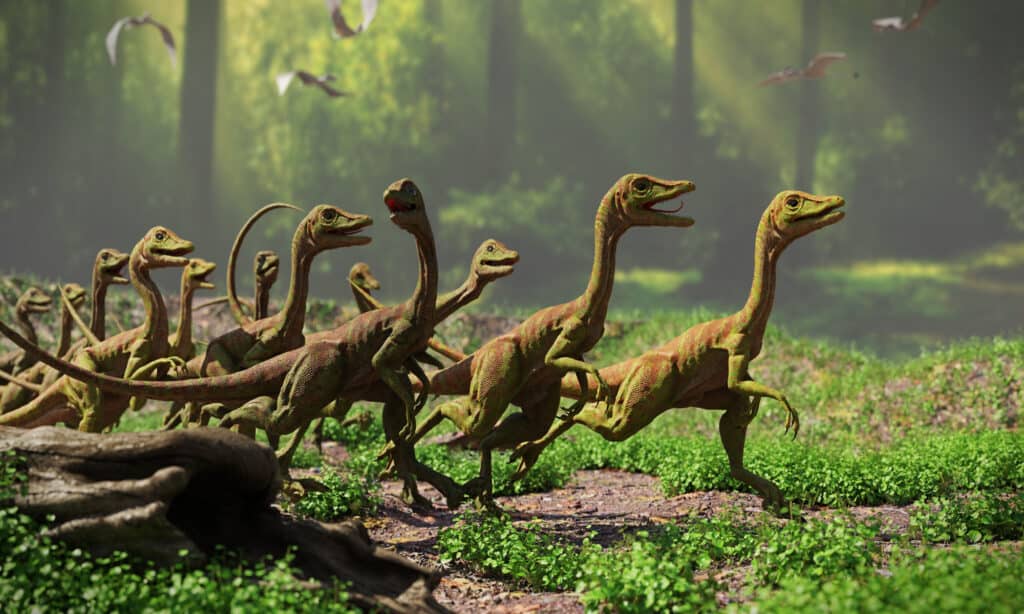
Dotted Yeti/Shutterstock.com
The compsognathus was a bird-like dinosaur that lived about 150 million years ago. Members of its genus could grow to around the size of a turkey; hence, they rank as one of the smallest dinosaurs. In fact, the compsognathus was considered the smallest dinosaur for a while until the more recent discovery of smaller raptor fossils. Despite their small size, they were also among the most active and intelligent.
Compsognathus was a meat eater and a fast, agile dinosaur. It had an EQ of 5.8 or lower. Scientists believe that this dinosaur preyed on swift animals, which means it must have had sharp senses and would need to be fast enough to keep up with its prey.
Oviraptor
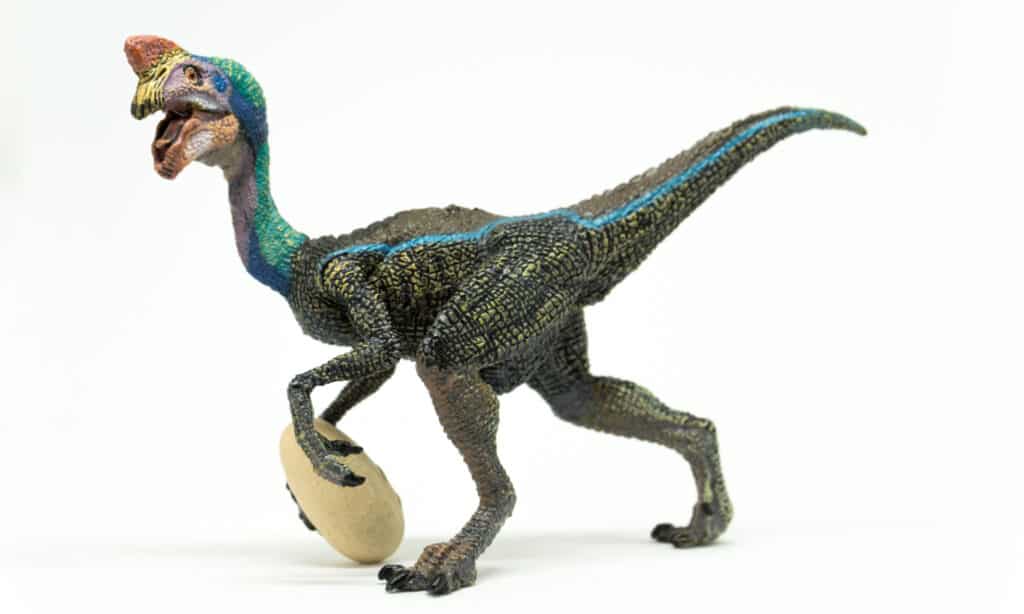
Noiel/Shutterstock.com
The first remains of an oviraptor were collected in 1923 from the Djadochta formation in Mongolia. The dinosaur was a small, bird-like omnivore that weighed between 73–88 lb. Scientists have long referred to this dinosaur as an egg thief. It wasn’t until recently that scientists discovered that this assumption wasn’t accurate. They found a fossil of this dinosaur on top of some eggs, which were later identified as embryonic oviraptors, contrary to the belief that it had been eating the eggs.
From all indications, oviraptors brooded and probably cared for their young — a pretty advanced behavior for dinosaurs. Like other raptors, oviraptors had a large brain, despite their small size, and must have demonstrated a high level of intelligence in the wild.
Tyrannosaurus rex (T-Rex)

Herschel Hoffmeyer/Shutterstock.com
The Tyrannosaurus rex is popularly regarded as the king of dinosaurs. T-rex was among the most recognizable dinosaurs. The giant meat-eating dinosaur walked on two powerful legs and had an enormous skull. Although it had a relatively small brain compared to its body, other sensory organs inside the head of the T-rex were gigantic and well-developed.
The Tyrannosaurus rex was a very intelligent dinosaur with an enormous olfactory bulb that gave it a strong sense of smell. Apart from this, its looping and long inner ear canals allowed rapid eye movements and quick reflexes. The cochlea’s adaptation allowed it to hear low-frequency sounds. The tyrannosaurus broke the stereotype that the smartest dinosaurs were small, feathered species. With an EQ of 1.9, the T-Rex was as smart as a chimpanzee. Some reports suggest that the adult dinosaur was gentle and careful with younger species. This dinosaur was one heavyweight no other dinosaur would want to mess with, not because of its sheer size but also its intelligence.
Allosaurus
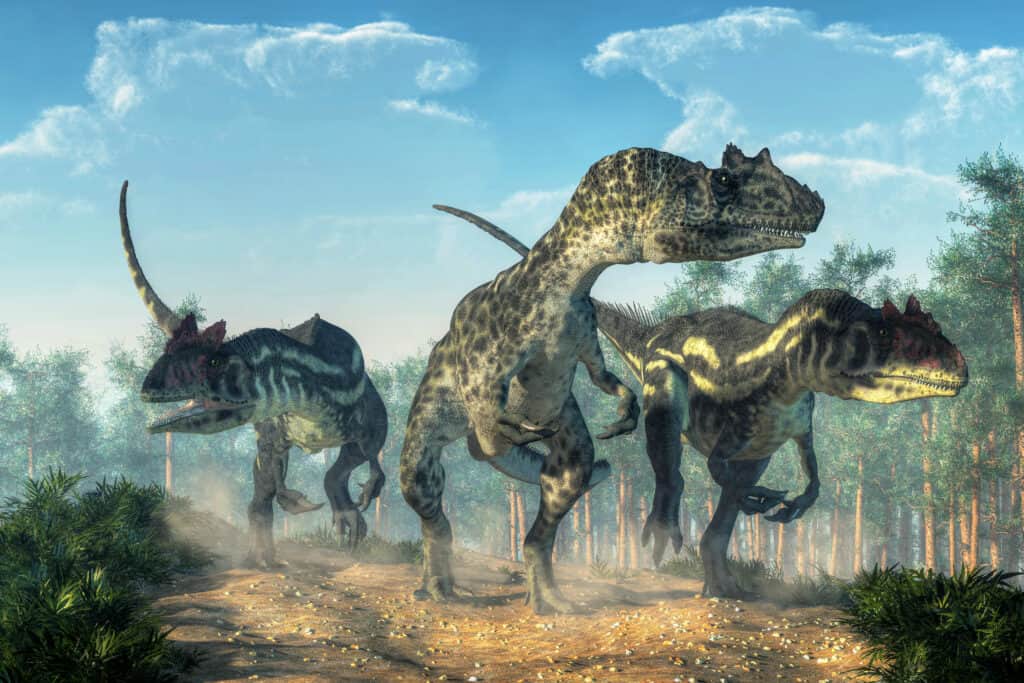
Daniel Eskridge/Shutterstock.com
Allosaurus was a dinosaur genus native to North America. The giant, meat-eating dinosaur was one of the biggest and most powerful predators. Although there are speculations that they could have hunted in groups, lone allosaurs could ambush and kill larger prey. This is thanks to their sharp, pointed teeth and powerful jaws.
The Allosaurus had an EQ between 1.0 and 1.6, which means it was also fairly intelligent. This dinosaur’s appearance was different from other dinosaurs known at the time. As a result, its name is derived from the Greek word Allos, meaning “different” or “other,” and sauros, meaning “lizard.”
Ornithomimus
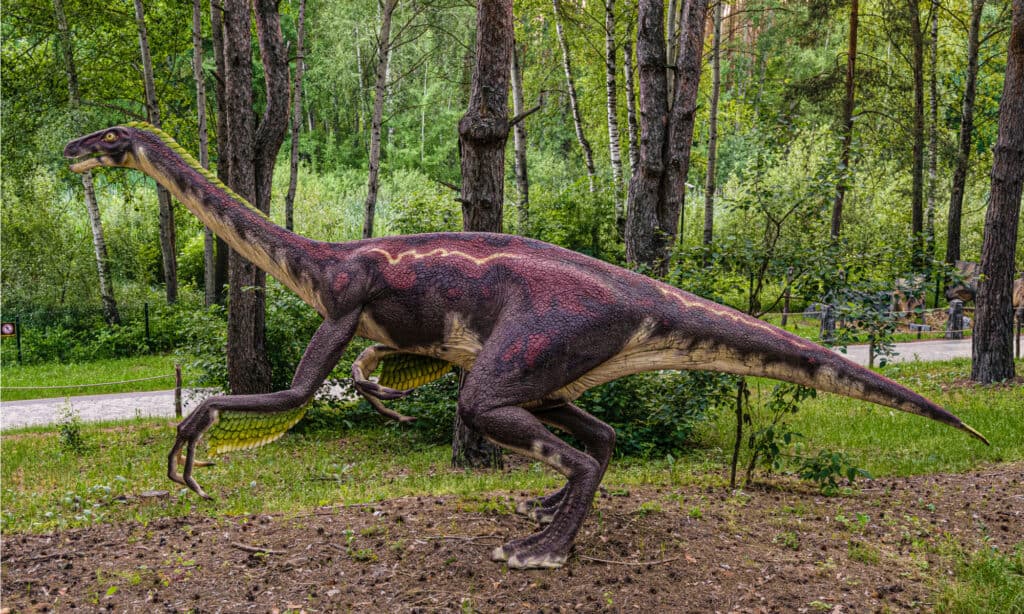
N-sky/Shutterstock.com
The irnithomimus appears similar to an ostrich in speed and intelligence. Unlike the ostrich, it had a long tail and a toothless, horny beak it used to feed on plants and small animals. The ornithomimus had a large brain for its small head, which suggests high intelligence.
Being compared to an ostrich today may not look great (an ostrich’s brain is about 0.015% of its total body weight.). Still, by Mesozoic era standards, they would have been among the most intelligent animals around. Apart from the brain, this dinosaur had large eyes, a long neck, long legs, and hollow bones which would have supported its swift movement.
Maiasaura
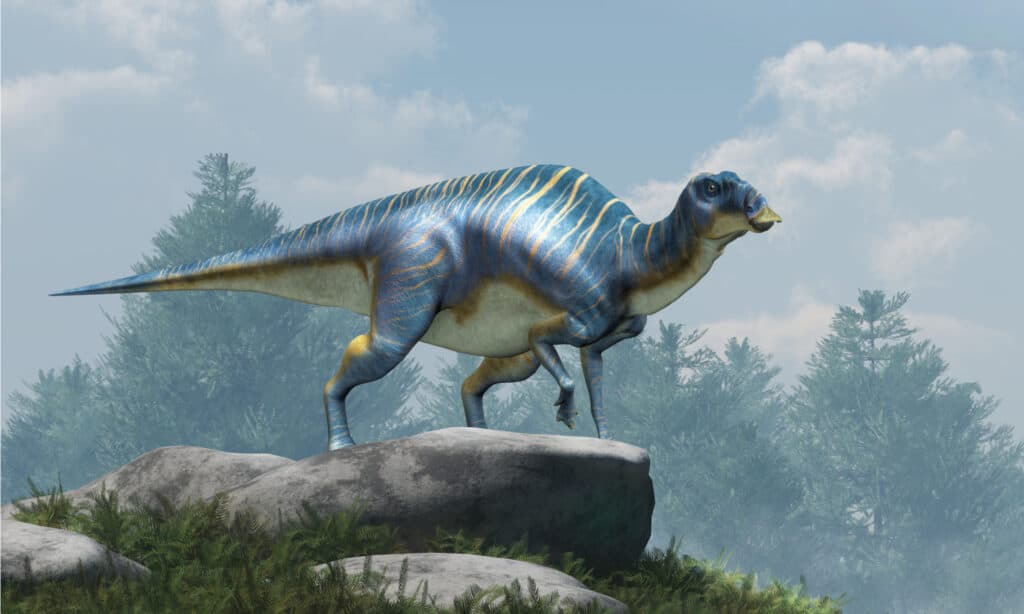
Daniel Eskridge/Shutterstock.com
We wrap our countdown of the smartest dinosaurs with the maiasaura. This dinosaur had a prominent appearance and fed on plants, making it the only plant-eating dinosaur smart enough to make this list. The first fossil was found alongside its young’s, eggs, and nests. As a result, paleontologists believe the dinosaur nurtured its young, which is why they were nicknamed “the good mother lizard.” This is a behavior only exhibited by smart animals.
Another study by Horner and colleagues suggested that adult maiasaura were smart enough to remember and return to the same nesting spot every year. The gentle giants lived in groups, as indicated by fossils of about 10,000 Maiasauras buried in volcanic ash in Montana.
Final Thoughts
Have you ever wondered what the world would look like if dinosaurs didn’t go extinct? Guess we’ll never find out. We hope our list of the smartest dinosaurs gives you some insight into how these giant beasts lived and adapted during their time here.
Up Next
The post Discover the 8 Smartest Dinosaurs Ever to Live — See Where T-Rex Ranks appeared first on AZ Animals.
from Animal News, Facts, Rankings, and More! - AZ Animals https://ift.tt/acJRUuL